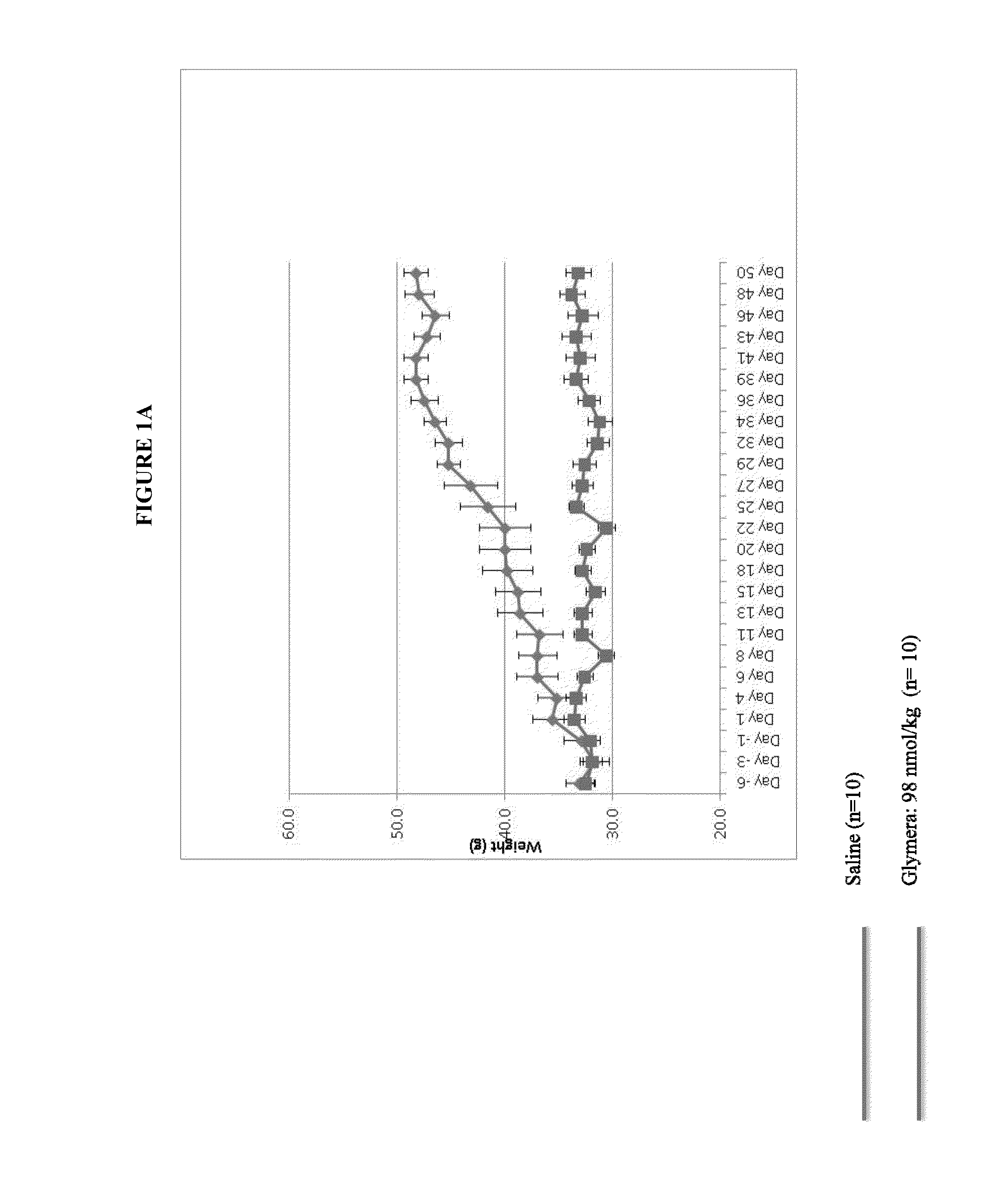Methods of treatment with glp-1 receptor agonists
a technology of glp-1 receptor and agonist, which is applied in the field of treatment with glp-1 receptor agonists, can solve the problems of short half-life, short half-life, and inability to interfere with or confuse the efficacy of the drug, so as to avoid a spike in serum level, induce weight loss, and control weight gain
- Summary
- Abstract
- Description
- Claims
- Application Information
AI Technical Summary
Benefits of technology
Problems solved by technology
Method used
Image
Examples
example s
Example 1
Diabetic Mouse Model
[0079]Glymera™ was administered at 5 mg / kg subcutaneously to diabetic mice (male, 14-15 weeks at start of study). Mice were fed a high calorie diet. Dosing was three times per week.
[0080]FIG. 1 shows prevention of weight gain in diabetic mice with administration of a GLP-1-ELP fusion protein (PB1023, or Glymera™). Panel A shows the weight of mice on a high calorie diet, and compares Glymera™ administration with saline. Glymera™ prevented weight gain, despite no changes in food consumption from saline (Panel B). The effect of Glymera™ in preventing weight gain is reversible upon cessation of dosing, as shown in FIG. 2. Glymera™ lowers postprandial glucose (FIG. 3A) and lowers blood glucose in the oral glucose tolerance test (FIG. 3B).
example 2
Phase I / II Single Ascending Dose Study and Multiple Ascending Dose Study
[0081]In summary, this Phase I / IIa study assessed multiple dose safety, tolerability, pharmacokinetics (PK) and pharmacodynamics (PD) in adults with type II diabetes. Subjects treated with 1 or 2 oral anti-diabetic drugs (OAD) discontinued their OADs during a 2 week run-in period. 56 subjects were randomized to weekly double blind injections of either placebo or Glymera™ for 4 weeks. Subjects were dosed after a liquid mixed meal tolerance test (MMTT). Safety, PK and PD were reviewed before escalation to the next dose of 0.3, 0.6, 0.9, and 1.35 mg / kg, respectively. PK exhibited slow absorption with sustained duration of exposure and minimal accumulation. Dose-response was evident for fasting plasma glucose (FPG), MMTT AUC glucose and average glucose (AG) assessed by continuous glucose monitoring (CGM). At the 1.35 mg / kg dose, placebo-adjusted AG change from baseline was −50 mg / dL (≈−1.8% A1C) (p<0.0001). AG showe...
example 3
Modeling of Nausea Rate as a Function of Pk Parameters
[0096]Logistic model is used to model the Nausea rate Pnau(or the probability of nausea events) given the concentration Cpk and rate of change Rpk of PK.
Log it(Pnau)=α+β1*Cpk+β2*Rpk (1)
where α, β1 and β2 are the model coefficients. Since PK is estimated only at specific time, i.e., 1 hour, 4 hour, 8 hour, etc, the corresponding PK concentration Cpk and rate of change Rpk at the nausea onset time is estimated using Spline. The whole analysis was done in R and SAS. Repeated measure effects are not considered.
[0097]The following procedures were used to fit the logistic model:[0098]1. Find all Nausea events whose onset time are within 7 days of Dose 1 and Dose 4.[0099]2. Create a dataset including all subjects. Two variables—Nausea and onset are created. If a subject does have Nausea at that time point, then Nausea=1, otherwise Nausea=0.[0100]3. Use R to fit Spline for each subjects' PK profile[0101]4. For each subject, estimate th...
PUM
| Property | Measurement | Unit |
|---|---|---|
| transition temperature | aaaaa | aaaaa |
| concentration | aaaaa | aaaaa |
| waist circumference | aaaaa | aaaaa |
Abstract
Description
Claims
Application Information
 Login to View More
Login to View More - R&D
- Intellectual Property
- Life Sciences
- Materials
- Tech Scout
- Unparalleled Data Quality
- Higher Quality Content
- 60% Fewer Hallucinations
Browse by: Latest US Patents, China's latest patents, Technical Efficacy Thesaurus, Application Domain, Technology Topic, Popular Technical Reports.
© 2025 PatSnap. All rights reserved.Legal|Privacy policy|Modern Slavery Act Transparency Statement|Sitemap|About US| Contact US: help@patsnap.com



